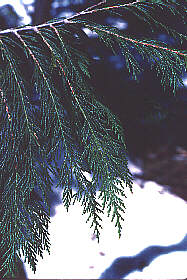| British Columbia Outdoor Wilderness Guide |

YELLOW CEDAR
chamaecyparis nootkatensis
- Other
common names for the Yellow Cedar: Nootka False-cypress,
Alaska-cypress, Sitka-cypress, Yellow-cypress, Alaska-cedar,
Alaska Yellow-cedar
- Yellow
Cedar is a False Cypress not a Cedar
- "nootkatensis"
refers to Nootka Sound on the west side of Vancouver
Island where it was first identified
UNIQUE
FEATURES:
- the
broad, grooved trunk of the Yellow Cedar spreads
out widely at the base
- Yellow
Cedar has
cone-shaped crown
- Yellow
Cedar branches
spread out and droop and have small, loosely hanging
branchlets
- Yellow
Cedar has a candelabra-like appearance
LOCATION:
- Yellow
Cedar is found west of the Coast Mountains and on
coast islands
- Yellow
Cedar extends to sea level on the northern coast
- Yellow
Cedargrows in mountains in southern BC
- Likes
deep, slightly acidic, moist soils
- Grows
singly or in small groups
SIZE:
- Yellow
Cedar grows up to 24 metres tall
- up
to 90 cm in diameter
CONES/FRUIT:
- rounded
cones
- 6
- 12 mm in diameter
- berry-like
in first year but later becoming woody
- 4
- 6 umbrella shaped scales on mature cones

 NEEDLES/LEAVES:
NEEDLES/LEAVES:
- scale-like
- dark,
bluish-green, slender
- twigs
appear four-sided
BARK:
- narrow
intersecting ridges on mature trees
- inside
bark smells like potato skins
WOOD
CHARACTERISTICS:
- pale
yellow
- hard,
very resistant to decay
- distinctive
fragrance
- straight
grain
USES:
- modern
- boat building
- traditional
- wood: ceremonial masks, paddles, dishes; bark:
clothing, blankets
|


Advertising
Sales Contacts:
Alan
Forseth
alan@ibcnetwork.com
Phone
(250) 377-4144 or Toll Free: 1-877-325-7770
|